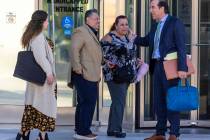‘A hole inside you’: Parents of BLM protester killed by police speak at trial
Parents of an armed Black Lives Matter protester shot to death by police testified Monday that the loss of their son has left a void.
“There’s a hole inside you,” said Jeanne Llera, the mother of Jorge Gomez. “When you lose a kid, it’s like you’ve lost a part of your heart.”
A federal civil trial over the 2020 death of Gomez, who was 25 at the time, is coming to a close this week. The trial stems from a lawsuit filed by Gomez’s family against the officers who fired on him as well as the Metropolitan Police Department.
Clark County prosecutors decided not the prosecute the four officers who shot at Gomez: Ryan Fryman, Dan Emerton, Andrew Locher and Vernon Ferguson.
John Squeo, a detective who fired a beanbag shotgun at Gomez before the fatal shooting, is also named as a defendant in the civil case.
During the trial, officers who fired shots have testified that Gomez pointed a rifle at them. Attorneys for Gomez’s family have denied that allegation.
The shooting occurred near the federal courthouse in downtown Las Vegas.
‘Good kid’
Llera testified that her son was a “good kid” who had a close relationship with his siblings, loved animals and was interested in baseball.
“I love all three of my kids the same, but my daughter used to say he was my favorite,” she told the jury.
Even in his 20s, he would still sit on her lap and give her a hug, said Llera, who cried and dabbed her eyes with a tissue during her testimony.
Gomez lived in Oregon — he wanted to experience all the seasons — but also lived in Las Vegas with his father and attended community college and UNLV, according to Llera.
She said Gomez planned to return to Oregon and finish college.
‘Not supposed to bury our kids’
Gomez’s father, Jorge Gomez, said he and his son were also very close.
He coached his son’s baseball team, he told jurors, and the two frequently fished at Lake Mead. The older Gomez has worked in casino security and helped his son find the same kind of job, he said.
Llera said Gomez was unemployed when he died because his workplace closed for the COVID-19 pandemic.
On June 1, 2020, the day of the shooting, Gomez dropped his father off at work, the elder Gomez said.
He knew his son planned to go to a protest over the death of George Floyd. The two planned to attend a protest together the following day.
Gomez had asked if he could bring a weapon to the protest, but did not say why he needed a gun that night, according to his father. Gomez’s father said he gave his son permission, adding that he had trained his son how to use firearms.
He confirmed that he instructed his son never to point a weapon at someone without the intention of using it.
Gomez’s death affects his father “every day,” the older Gomez testified. Weeks after his son’s death, he told the jury he suffered a heart attack.
He does not think he will ever be the same.
“We’re not supposed to bury our kids,” he said.
Defense medical expert testifies
Gary Vilke, an emergency physician called as a defense witness, testified about the way Gomez may have felt the beanbag rounds before the fatal shooting.
The beanbags surprised him and knocked him down, but the pain he may have felt was likely blunted by a surge of adrenaline in that chaotic moment, he said.
Once Gomez suffered a gunshot wound to the head, Vilke said, he would have immediately lost consciousness and not experienced pain or suffering. Other wounds would have caused him surprise and shock, the doctor testified.
Bennet Omalu, a forensic pathologist retained by the plaintiffs, testified Friday that Gomez would have suffered “one of the highest levels of pain a human being can experience.”
‘Something is off’
Detective Boe Dennett told jurors he noticed Gomez behaving suspiciously and told Squeo: “Something is off about this guy. We need to watch him.”
Dennett said Gomez’s right arm was pinned to his side as if he was trying to hide something. Police had issued a dispersal order and Squeo told him to move along, Dennett testified. Gomez walked slowly, then stopped moving, Dennett said.
He testified that he told Squeo to arrest Gomez based on the dispersal order. Police approached to make the arrest. Dennett, who was wearing a gas mask that night, said he saw Gomez’s hand start to come up holding something that he thought was a pipe or bat.
Squeo then shot Gomez with the beanbag gun, according to Dennett.
Squeo has testified that he fired the beanbag gun because he believed Gomez was about to attack a colleague.
Gomez turned and started running. Dennett said he realized the object Gomez held was a gun. Gomez ran toward a crowd of people with the gun sticking away from his body in a firing position, the detective said.
Dennett conceded that while he testified in court that the gun did not skid away when Gomez fell at one point, he previously said the gun did skid.
Gomez lifted the gun up and then the gun started to come down and the man ran out of view, Dennett testified. He said he did not see Gomez point a rifle at officers before he disappeared.
Seconds later, he said, officers fired shots.
Contact Noble Brigham at nbrigham@reviewjournal.com. Follow @BrighamNoble on X.


















